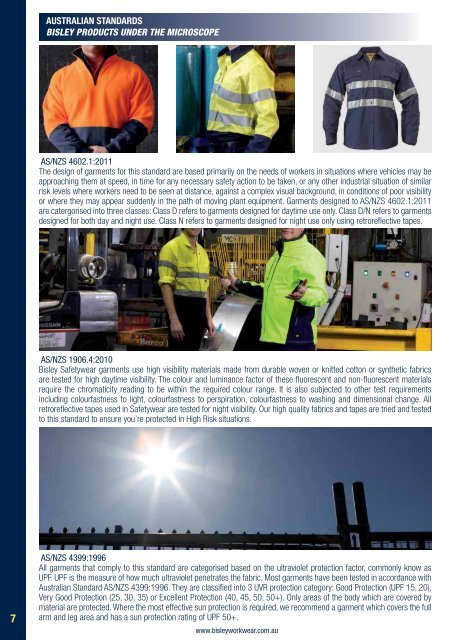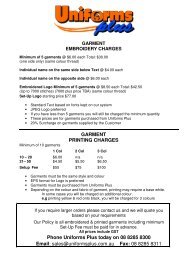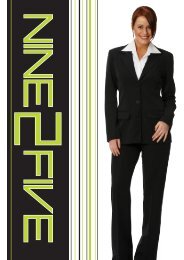You also want an ePaper? Increase the reach of your titles
YUMPU automatically turns print PDFs into web optimized ePapers that Google loves.
AUSTRALIAN STANDARDS<br />
BISLEY PRODUCTS UNDER THE MICROSCOPE<br />
AUSTRALIAN & INTERNATIONAL STANDARDS<br />
BISLEY PRODUCTS UNDER THE MICROSCOPE<br />
AS/NZS 4602.1:2011<br />
The design of garments for this standard are based primarily on the needs of workers in situations where vehicles may be<br />
approaching them at speed, in time for any necessary safety action to be taken, or any other industrial situation of similar<br />
risk levels where workers need to be seen at distance, against a complex visual background, in conditions of poor visibility<br />
or where they may appear suddenly in the path of moving plant equipment. Garments designed to AS/NZS 4602.1:2011<br />
are catergorised into three classes: Class D refers to garments designed for daytime use only. Class D/N refers to garments<br />
designed for both day and night use. Class N refers to garments designed for night use only using retroreflective tapes.<br />
AS/NZS 1020:1995<br />
Bisley Workwear offers a large range of natural cotton fibre products, which naturally avoid the generation of static electricity<br />
by remaining neutral, therefore increasing the wearer’s comfort. If the wearer is prone to dry skin, especially in winter<br />
months, it is strongly recommended that 100% Cotton garments are worn against the skin. Synthetic undergarments may<br />
counteract this advantage so, where possible, it’s always best to wear natural fibre undergarment.<br />
Garments with theStatic Control icon comply to AS/NZS 1020:1995 as attributing to controlling undesirable static electricity.<br />
AS/NZS 1906.4:2010<br />
Bisley Safetywear garments use high visibility materials made from durable woven or knitted cotton or synthetic fabrics<br />
are tested for high daytime visibility. The colour and luminance factor of these fluorescent and non-fluorescent materials<br />
require the chromaticity reading to be within the required colour range. It is also subjected to other test requirements<br />
including colourfastness to light, colourfastness to perspiration, colourfastness to washing and dimensional change. All<br />
retroreflective tapes used in Safetywear are tested for night visibility. Our high quality fabrics and tapes are tried and tested<br />
to this standard to ensure you’re protected in High Risk situations.<br />
AS/NZS 2392:1999<br />
Bisley Workwear garments<br />
meet the requirements of<br />
AS/NZS 2392:1999 which<br />
outlines the method for<br />
permanent labelling with<br />
the brand name, size, care<br />
instructions, fibre content<br />
and country of origin.<br />
AS/NZS 2622:1996<br />
Bisley Workwear garments<br />
meet the requirements of<br />
AS/NZS 2622:1996 which<br />
outlines the method for<br />
labelling of fibre content in<br />
textile products.<br />
AS/NZS 1957:1998<br />
Bisley Workwear garments<br />
meet the requirements of<br />
AS/NZS 1957:1998 which<br />
outlines the care instructions<br />
needed to ensure proper<br />
care of the garment.<br />
ASTM D5489-07<br />
For ease of care, this<br />
garment has care symbols to<br />
eliminate language barriers<br />
in garment cleaning. These<br />
symbols are included to<br />
comply with United States<br />
of America Standard ASTM<br />
D5489-07.<br />
AS 2001.2.18-1987<br />
Bisley Workwear ‘water-proof’ garments are tested to the Australian Standard AS 2001.2.18:1987. The fabric has been<br />
deemed compliant when no water has passed through it over an 18hour period. These garments have a water-repellent or<br />
water-resistant coating which stops moisture from reaching the wearer in wet-weather conditions.<br />
7<br />
AS/NZS 4399:1996<br />
All garments that comply to this standard are categorised based on the ultraviolet protection factor, commonly know as<br />
UPF. UPF is the measure of how much ultraviolet penetrates the fabric. Most garments have been tested in accordance with<br />
Australian Standard AS/NZS 4399:1996. They are classified into 3 UVR protection category: Good Protection (UPF 15, 20),<br />
Very Good Protection (25, 30, 35) or Excellent Protection (40, 45, 50, 50+). Only areas of the body which are covered by<br />
material are protected. Where the most effective sun protection is required, we recommend a garment which covers the full<br />
arm and leg area and has a sun protection rating of UPF 50+.<br />
www.bisleyworkwear.com.au<br />
ISO 14184-1.1998<br />
Fabrics used in Bisley Workwear garments are tested regularly to ensure that naturally created formaldehyde levels are<br />
kept to the safe minimum standard set out by the ACCC (Australian Competition & Consumer Commission) and are tested<br />
in accordance with International Standard ISO 14184-1:1998. Bisley Workwear garments are free from formaldehyde.<br />
www.bisleyworkwear.com.au<br />
8




